about what?
worum gehts?
Hearing - the underestimated sense - it provides you vision in the darkness.
HiFi horn loudspeaker My optimum
- Listening area room size 20-80 qm - point source
- distance 2,5-8 meter - no crossover network
- SPL max. 100 dB - horn housing
less is more !
the DIY benefit
Up to 80% of the manufacturing costs for a bass horn lies in building the cabinet.
What about additional costs for trade profit margins and transport !?
Both can be removed from the Project Budget if you do it yourself.
What about additional costs for trade profit margins and transport !?
Both can be removed from the Project Budget if you do it yourself.
Context:
- the loudspeaker is by far the weakest member in the sound reproduction chain,
a LS on average has less than 1% efficiency, i.e. 99% of the energy sent to the
LS will be lost as heat, the remaining energy will produce the actual sound
- an inexpensive LS lead of 1,5 square mm is quite sufficient up to 10 m
- connection terminals are never better than the wire
- approx 70% of the cost of a sound system should be spent on the loudspeakers
- the standard pitch tone (a) has the frequency 440 Hz
- this note lies very close to the center of the violin clef
- nearly 90 % of all played notes are 2 octaves over and below this note
- your amplifier delivers only ca 1 Watt peak effect to the speakers base drum to
reproduce a beat on a base drum with the volume control standing at "10 o'clock"!!
- normal speech has a sound pressure level of about 60 dB
- a bad recording cannot be compensated by even the best of sound reproduction equipment
unfortunately only approx. 2 out of 10 CD's contain high quality recordings
- due to today's furnishing (leather, parquet, shutters, glass),
I consider a strong direct sound something to be prefered
- if you are positioned closely (40-70cm) to a wall, you should use
"wall rug", 4 cm in front on the wall behind your head
- bad room charateristics can be checked by way of hand claps by a person in front
of the LS diaphragm, while the other person sits in the normal listening position,
hence disclose any flutter echo
- by damping the room corners, with for instance partly (3/4 ) filled bookshelves
opposite to the LS, it is possible to improve the room acoustics
- the room acoustics and the listening position are very important factors,
mainly because you can influence them
- placing a heavy concrete slab (the normal garden Walk-path type) on a piece of
thick rug in your room and using adjustable spikes between LS and the slab is a cheap,
worthwhile solution
- over 90% of the resulting reproduced sound from a good recording, depends on:
the room, the drivers, the building elements used for the cabinet
and the cabinet design. The remaining percentages may be obtained through careful
choices of electronics for signal processing, cabels and equipment dampers etc.
- When you are satisfied with the sound, when you have an emotional or
relaxing listening experience, then is also the sound correct
- persons with limited, or no experience from speaker comparizons, should always
ask for a possibility to listen to an established and well known "Reference speaker
in a listening room for comparison.
ask for a possibility to listen to an established and well known "Reference speaker
in a listening room for comparison.

An important building material for my horn
constructions is the soft fiber, usually
11-13 mm thick, and with a paper layer
pasted on one side, always glue with
this page. You can work on the material
with a carpet knife easily. Also called
sound reducing board and very low-price,
it is used with bass horns to silence
1/4 Lamda over 100 Hz.
Why?
A horn is the most natural and efficient way to produce sound.
With horns, the moving mass can be reduced about 90% and the
performance can be increased up to 15 dB SPL. Due to the very
small membrane movements needed, the bass plays faster and more lively.
This is the main reason for choosing this hobby since 1972 with various
speakers variants, however since 1980 exclusively horns.
The art of speaker development consists of omitting, minimizing and simplifying,
the resulting sound reproduction will have less distortion, and can also follow
the weakest of pulses, since each unnecessary component changes the signal
and distorts the music reproduction.
Any given speaker creates a signal-depending load on an amplifier, depending
on the the music signal, the more complex, the greater are the feedback to the
amplifiers, with negative implications on the signal processing.
Therefore, I scarcely use anything but fullrange drivers without any crossover in my horns.
Why do I mostly use small bass speaker?
The inertia of the a heavy membrane slows the music signal down and this is especially
noticeable on lower sound levels, typical for a normal living room, where the larger
the mass of the membrane, the more it will dampen the signal, which is the main reason
for the serious lack of bass resolution in heavy bass membranes.
How can this be improved?
Through the courage of the developer, to question supposedly irrefutable principles
and to follow your own paths. The series of double horns are prime examples of
improvement in horn innovation and minimized enclosure sizes.
What difference can membrane movement interlacing
and bass horn mouth distance make?
An extension of the low-transmission area by at least one octave, reducing
the housing volume by up to 50%, in comparison to a single driver solution.
Indirectly right / left radiation and bass horn mouth distance prevents sound
pressure increase over 100 Hz, reduction and linearization of membrane stroke
gives a very fast, tight, contoured and clean bass response, with outstanding
properties. The double horns presented her are an unexpected and
sensational development of the horn principle. I didn't expect that the expression
"less is more" once again would prove to be so very true.
Some of the fundamental principles and theories for horns now need
to be reviewed and rewritten.
My research shows clearly: in normal living rooms is the funnel constant and
length of a bass horn far more important than the horn mouth opening.
That nobody got this in the last century is absolutely incomprehensible to me!
With horns, the moving mass can be reduced about 90% and the
performance can be increased up to 15 dB SPL. Due to the very
small membrane movements needed, the bass plays faster and more lively.
This is the main reason for choosing this hobby since 1972 with various
speakers variants, however since 1980 exclusively horns.
The art of speaker development consists of omitting, minimizing and simplifying,
the resulting sound reproduction will have less distortion, and can also follow
the weakest of pulses, since each unnecessary component changes the signal
and distorts the music reproduction.
Any given speaker creates a signal-depending load on an amplifier, depending
on the the music signal, the more complex, the greater are the feedback to the
amplifiers, with negative implications on the signal processing.
Therefore, I scarcely use anything but fullrange drivers without any crossover in my horns.
Why do I mostly use small bass speaker?
The inertia of the a heavy membrane slows the music signal down and this is especially
noticeable on lower sound levels, typical for a normal living room, where the larger
the mass of the membrane, the more it will dampen the signal, which is the main reason
for the serious lack of bass resolution in heavy bass membranes.
How can this be improved?
Through the courage of the developer, to question supposedly irrefutable principles
and to follow your own paths. The series of double horns are prime examples of
improvement in horn innovation and minimized enclosure sizes.
What difference can membrane movement interlacing
and bass horn mouth distance make?
An extension of the low-transmission area by at least one octave, reducing
the housing volume by up to 50%, in comparison to a single driver solution.
Indirectly right / left radiation and bass horn mouth distance prevents sound
pressure increase over 100 Hz, reduction and linearization of membrane stroke
gives a very fast, tight, contoured and clean bass response, with outstanding
properties. The double horns presented her are an unexpected and
sensational development of the horn principle. I didn't expect that the expression
"less is more" once again would prove to be so very true.
Some of the fundamental principles and theories for horns now need
to be reviewed and rewritten.
My research shows clearly: in normal living rooms is the funnel constant and
length of a bass horn far more important than the horn mouth opening.
That nobody got this in the last century is absolutely incomprehensible to me!
Especially since my subsequent research in the psychoacoustic effect of residual listening
noticed in organ triads. Wiki: "This phenomenon has long been used in organ building:
With the simultaneous use of the 8-foot and 51/3-Fuß which is about a fifth, you can hear
the 16-foot, one octave below the 8-foot. This enables an absence of tone simulating
sound in the two-tone generator to the octave and the twelfth pure while the tone is
not really existing. "
In my double horns measurements however, I used a microphone, so it can not be
a matter of a psycho acoustic effect. In reality, the double horn reproduces
frequencies at least one octave lower in comparison to the single horn simulations.
Why is the bass of the double horns so tight, effortless and fast?
noticed in organ triads. Wiki: "This phenomenon has long been used in organ building:
With the simultaneous use of the 8-foot and 51/3-Fuß which is about a fifth, you can hear
the 16-foot, one octave below the 8-foot. This enables an absence of tone simulating
sound in the two-tone generator to the octave and the twelfth pure while the tone is
not really existing. "
In my double horns measurements however, I used a microphone, so it can not be
a matter of a psycho acoustic effect. In reality, the double horn reproduces
frequencies at least one octave lower in comparison to the single horn simulations.
Why is the bass of the double horns so tight, effortless and fast?
Through membrane movement interlacing there are more bass, due to the bass
horn mouth distance, there's no rise above 100 Hz. So the pressure chamber can
be kept extremely small, both horns are extremely small. Small is also the air mass
in the horn and the wall-to-wall distance inside the horn is short, the impedanz is
very flat, no bassresonanz, the relatively small cabinets also contributes to the
fast, contoured bass reproduction.
horn mouth distance, there's no rise above 100 Hz. So the pressure chamber can
be kept extremely small, both horns are extremely small. Small is also the air mass
in the horn and the wall-to-wall distance inside the horn is short, the impedanz is
very flat, no bassresonanz, the relatively small cabinets also contributes to the
fast, contoured bass reproduction.
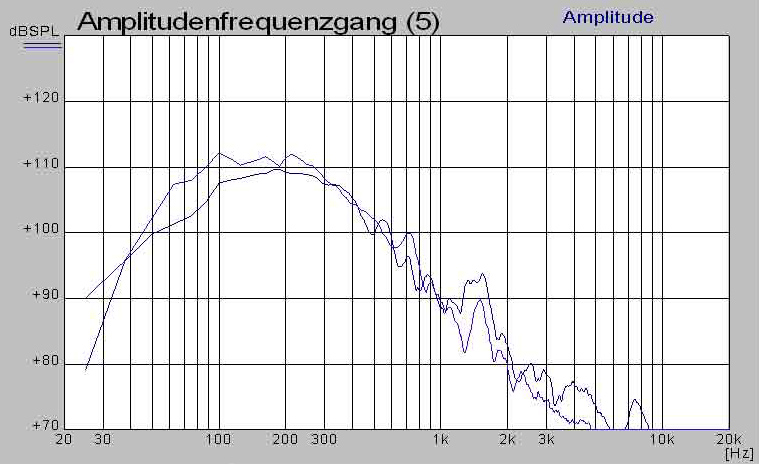
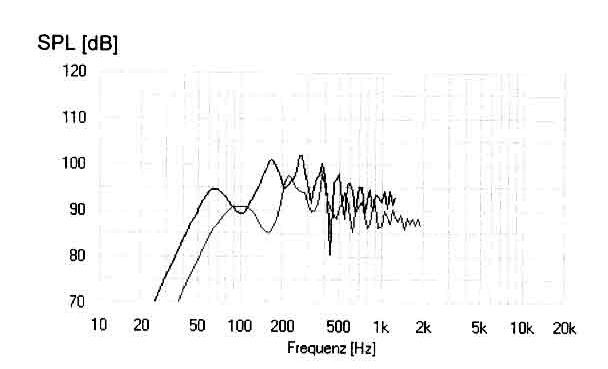
An attempt to explain
these graphs:
By way of parallel
operation of the two
different horns, the
driver of the long horn
controls the stroke of
the driver in the short
horn. The little horn
will not be acoustic short
circuited, but instead
creates sound pressure,
amazingly much, more
pressure than the long
horn below 40 Hz.
At the same time, the
impedance peak of the
lowest octave is eliminated
by non-interlacing,
below 50 Hz~4 Ohm.
See system horn mouth
measurement and single
simulation of the
CORNET and impedanz.
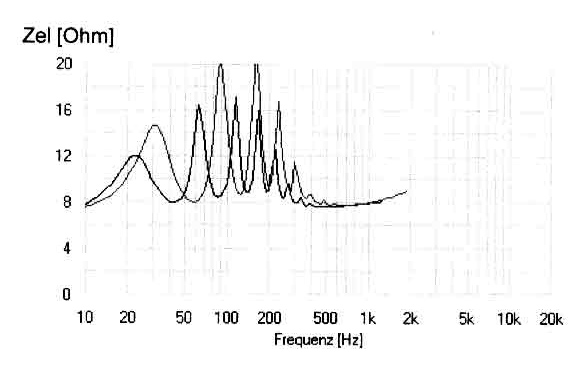
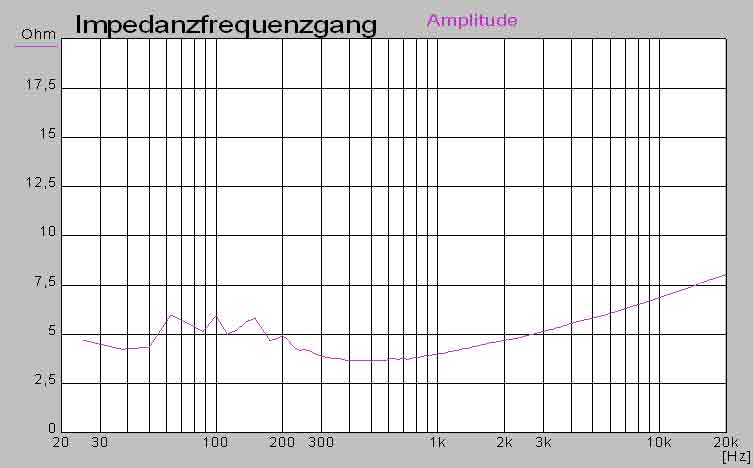
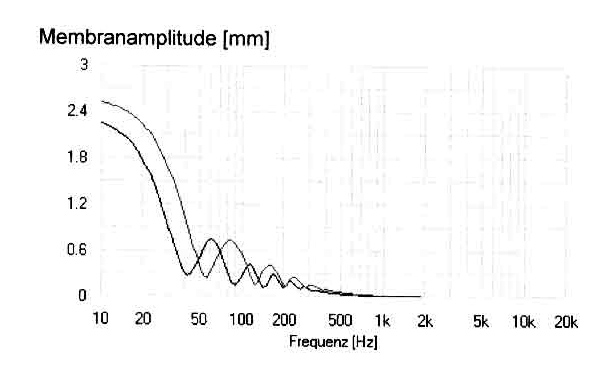
Membran movement
interlacing:
My haptic verifications
show a rather linear
membrane movement,
similar to a normal
distribution curve.
Which means a reduction
of "pressure changes",
and hence less mechanical
membrane stress and
maximized sound and SPL.
Still a funny phrase out of quantum mechanics, exchanging of just one word yields:
Two or more horns can be called interlaced if it can´t be described independently from each other. ;-))
"Without music life would be a mistake," F. Nietzsche

copyright hm-moreart Horst Möller 2007